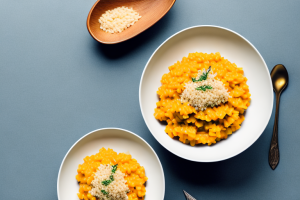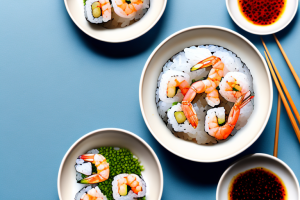How to stir-fry jasmine rice with shrimp
9 min read
A pan with jasmine rice and shrimp being stir-fried
Stir-frying jasmine rice with shrimp is a quick and easy way to create a delicious meal that’s both filling and nutritious. It’s a dish that can easily be customized to suit individual tastes, with different herbs, spices, and vegetables added to create a unique flavor profile. In this article, we’ll cover everything you need to know to prepare the perfect stir-fried jasmine rice with shrimp, from choosing the right ingredients to serving the dish with flair.
Preparing the ingredients for stir-frying jasmine rice with shrimp
The first step in creating a delicious stir-fry is to prepare all of your ingredients. This means cleaning and deveining your shrimp, washing and chopping your vegetables, and measuring out your rice. It’s important to have everything ready before you start cooking, as stir-fries cook up quickly and you don’t want to burn anything while you’re chopping or measuring. To save time, consider using pre-chopped vegetables or precooked shrimp.
Once you have all of your ingredients ready, it’s time to start cooking. Heat up your wok or frying pan over high heat and add some oil. Once the oil is hot, add your shrimp and stir-fry for a few minutes until they turn pink. Remove the shrimp from the pan and set them aside.
Next, add your vegetables to the pan and stir-fry for a few minutes until they are tender-crisp. Add your cooked rice to the pan and stir-fry for a few more minutes until everything is heated through. Finally, add your shrimp back to the pan and stir everything together. Serve hot and enjoy!
Choosing the right type of shrimp for your stir-fry
When it comes to shrimp, size matters. In a stir-fry, it’s best to use medium to large shrimp, as smaller shrimp can easily overcook and become tough. You’ll also want to look for shrimp with firm, translucent flesh and a fresh, ocean scent. Avoid any shrimp that smell fishy or have a slimy texture.
Another important factor to consider when choosing shrimp for your stir-fry is the sustainability of the shrimp. Look for shrimp that are certified by organizations such as the Marine Stewardship Council or the Aquaculture Stewardship Council, which ensure that the shrimp are farmed or caught in an environmentally responsible way. By choosing sustainable shrimp, you can help protect the health of our oceans and ensure that future generations can continue to enjoy this delicious seafood.
The benefits of using jasmine rice in your stir-fry
Jasmine rice is a long-grain variety of rice that has a slightly sweet, nutty flavor. It’s a popular choice for stir-fries because it absorbs flavors well and provides a fluffy, slightly sticky texture. Additionally, jasmine rice is a healthy alternative to other types of rice, as it’s low in fat and high in fiber.
Another benefit of using jasmine rice in your stir-fry is that it has a lower glycemic index compared to other types of rice. This means that it can help regulate blood sugar levels and keep you feeling fuller for longer periods of time.
Furthermore, jasmine rice is a good source of essential vitamins and minerals such as thiamin, niacin, and vitamin B6. These nutrients are important for maintaining a healthy metabolism and promoting overall well-being.
The secret to perfectly cooked jasmine rice in a stir-fry
The trick to perfect jasmine rice is to get the ratio of rice to water just right. For every cup of rice, you’ll need 1 1/2 cups of water. Rinse the rice in cold water until the water runs clear, then add it to a pot with the measured water. Bring to a boil, then reduce the heat to low and cover. Cook for 15-20 minutes, or until the water is absorbed and the rice is tender. Remove from heat and let sit covered for an additional five minutes before fluffing with a fork.
Another important tip for cooking jasmine rice in a stir-fry is to use cold, cooked rice. This means that you should cook the rice ahead of time and let it cool completely before using it in your stir-fry. Cold rice will not stick together and will absorb the flavors of the stir-fry sauce better than warm or freshly cooked rice. So, if you want to take your stir-fry game to the next level, make sure to cook your jasmine rice in advance and let it cool before using it in your dish.
Tips for achieving the perfect consistency and texture in your stir-fried rice
When it comes to stir-frying rice, the key is to keep the grains separate and evenly coated in oil. Use a wok or large, deep skillet and heat it over high heat. Add a tablespoon of oil and swirl it around to coat the bottom and sides. Add your cooked, cooled, and fluffed rice and stir-fry for 2-3 minutes, or until heated through and evenly coated in oil. Be gentle with the rice and use a spatula to toss it occasionally.
Another important tip for achieving the perfect consistency and texture in your stir-fried rice is to use day-old rice. Freshly cooked rice tends to be too moist and sticky, which can result in clumpy and mushy stir-fried rice. By using day-old rice, the grains have had time to dry out slightly, making them easier to separate and giving them a better texture when stir-fried.
Additionally, you can add some flavor to your stir-fried rice by incorporating different ingredients. For example, you can add diced vegetables such as carrots, peas, and bell peppers, or protein such as chicken, shrimp, or tofu. You can also add sauces such as soy sauce, oyster sauce, or sesame oil to enhance the flavor of your stir-fried rice. Just be sure to add these ingredients towards the end of the stir-frying process, so they don’t overcook and become mushy.
Adding flavor to your stir-fried jasmine rice with shrimp using herbs and spices
Herbs and spices are a great way to add additional flavor to your stir-fry. Consider using garlic, ginger, green onions, chili peppers, or lemongrass. You can also add a pinch of ground cumin, coriander, or turmeric to give your stir-fry a more complex flavor profile. Be careful not to overdo it, as too many spices can overpower the dish.
Another way to add flavor to your stir-fried jasmine rice with shrimp is by using different types of oils. Instead of using regular vegetable oil, try using sesame oil or coconut oil for a unique taste. You can also add a splash of soy sauce or fish sauce for a savory umami flavor. Experiment with different combinations of herbs, spices, and oils to find the perfect flavor for your stir-fry.
The importance of using high-quality oil in your stir-fry
The right oil can make or break a stir-fry, so it’s important to choose one that has a high smoke point, like canola or peanut oil. Additionally, using a flavorful oil like sesame oil can add a delicious nutty flavor to your dish.
It’s also important to consider the health benefits of the oil you choose. Opting for oils that are high in unsaturated fats, like olive oil or avocado oil, can help lower cholesterol levels and reduce the risk of heart disease. On the other hand, oils high in saturated fats, like coconut oil or palm oil, should be used sparingly as they can increase cholesterol levels and contribute to heart disease.
Techniques for properly seasoning and marinating your shrimp before cooking
Seasoning your shrimp before cooking can give them a boost of flavor. You can use a simple mixture of salt and black pepper, or get creative with herbs and spices. A quick marinade of soy sauce, garlic, and ginger can add a delicious umami flavor to your shrimp.
Another technique for seasoning and marinating your shrimp is to use citrus juices. Lemon, lime, and orange juices can add a bright, tangy flavor to your shrimp. You can also add some zest from the citrus fruit to enhance the flavor even more. Another option is to use a mixture of olive oil, herbs, and garlic to marinate your shrimp before cooking. This can add a rich, savory flavor to your dish.
How to properly sauté shrimp for a deliciously crispy texture
When it comes to cooking shrimp, a quick sauté is the best method for achieving a crispy, golden-brown exterior. Heat a tablespoon of oil in a non-stick skillet over high heat until it shimmers. Add your shrimp in a single layer, making sure not to overcrowd the pan. Cook for 1-2 minutes on each side, or until the shrimp are opaque and golden-brown. Remove from the pan and set aside.
For an extra burst of flavor, consider adding garlic or shallots to the pan before adding the shrimp. Sauté them until they are fragrant and slightly softened, then add the shrimp to the pan. This will infuse the shrimp with a delicious garlic or shallot flavor.
Another tip for achieving a crispy texture is to pat the shrimp dry with a paper towel before cooking. This will remove any excess moisture and prevent the shrimp from steaming in the pan, resulting in a crispier exterior.
Adding vegetables to your stir-fry for added nutrition and flavor
Vegetables are a key component of any stir-fry. Consider using bell peppers, onions, snow peas, bean sprouts, broccoli, or carrots. Add your vegetables in order of cooking time, with harder vegetables like carrots and broccoli going in first, and softer vegetables like snow peas and bean sprouts going in last. You want your vegetables to be cooked but still crunchy.
In addition to adding flavor and nutrition, using a variety of colorful vegetables in your stir-fry can also make it visually appealing. Try using red and yellow bell peppers, purple onions, and green broccoli to create a colorful and appetizing dish. Don’t be afraid to experiment with different vegetables and flavor combinations to find your favorite stir-fry recipe.
Tips for achieving the perfect balance of sweetness, saltiness, and umami in a stir-fry
A good stir-fry should have a balance of sweet, salty, and savory flavors. To achieve this, consider using a combination of sugar, soy sauce, oyster sauce, and rice wine vinegar. Be sure to taste your stir-fry as you go and adjust the seasoning as needed.
Another tip for achieving the perfect balance of flavors in a stir-fry is to use fresh ingredients. Fresh vegetables and meats will have more natural flavors that can enhance the overall taste of your dish. Additionally, try to avoid overcooking your ingredients as this can lead to a loss of flavor and texture. Keep your stir-fry ingredients moving quickly in the pan to ensure they cook evenly and retain their natural flavors.
Serving suggestions and plating ideas to elevate your dish
When it comes to plating a stir-fry, simplicity is key. Serve your stir-fried rice and shrimp in a large bowl or platter, garnished with chopped cilantro or green onions. You can also add a wedge of lime or lemon for an extra burst of flavor. Alternatively, you can serve your stir-fry in individual bowls or plates for a more elegant presentation.
Common mistakes to avoid when making a jasmine rice and shrimp stir-fry
One common mistake when making a stir-fry is overcrowding the pan. You want to make sure your ingredients have room to cook evenly. Another mistake is overcooking your shrimp, which can make them tough and rubbery. Make sure to only cook them for 1-2 minutes on each side before removing them from the pan. Finally, be sure to taste your dish as you cook and adjust the seasoning as needed, as everyone’s tastes are different!
And there you have it, a guide to making the perfect jasmine rice and shrimp stir-fry. With a little practice, this dish can become a go-to for a quick and delicious meal. Enjoy!


